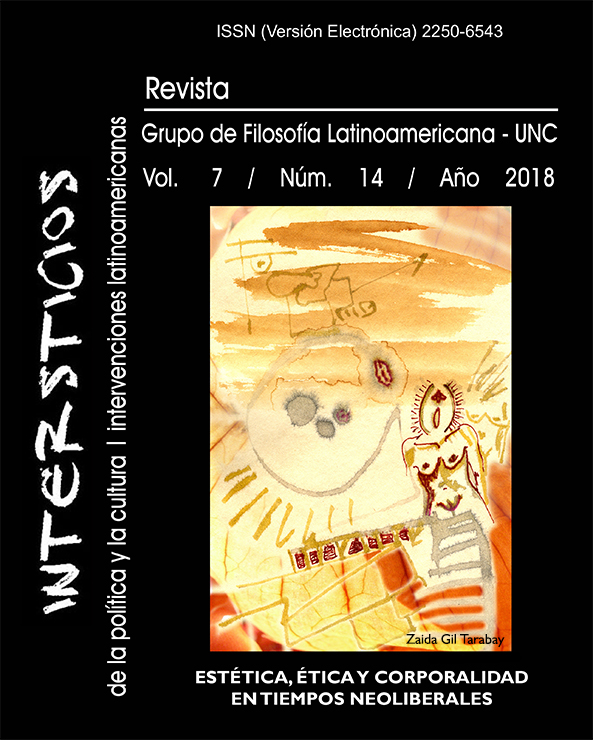We, the others. The exercise of rights in the “Marcha de la gorra”
Keywords:
performativity, mourning, precarization, othernessAbstract
Who are we "us"? What edges meet us, what limits gather us, what exclusions produce us? And who are "the others"? What is the trace that expels them? In what way are their lives administeres from state institutions? Is it from the systematic omission? Is it from the blinding promise of security? In this paper I will propose an analysis on the problem and the possibility of the construction of those "us", particularly in relation to the configurations that they adopt in and around the annual event of the March of the Cap in Córdoba. Without ignoring that perhaps pointing out the limits of "us" and "the others" is, as Butler says, an insoluble problem, I try in these pages to give an account of the ways in which these otherness are built from the state violence in the province of Córdoba. I also emphasize here the ways in which the sectors of the population that are harmed meet, build community and take public space within the framework of the March. There they act some of the rights that are denied to them and they give account of the precarity of which they are object daily, doing the public duel by the deaths that the society - the other "us" - does not cry. Noting, in short, that they resist the policies of misery, expropriation, murder and systematic violence to which they are subjected by a differential government of life, a racist State. And it is through that resistance that they become a community, that they affirm themselves as lives.Downloads
References
Bonvillani, A. (2015). Callejeando la alegría...y también el bajón. Córdoba: Encuentro Grupo Editor.
Bonvillani, A. y Roldán, M. (2017). “Politización de los cuerpos juveniles: la Marcha de la Gorra como performance multitudinaria”. En Aposta. Revista de Ciencias Sociales (número 74), pp. 165-203, Recuperado de http://apostadigital.com/revistav3/hemeroteca/bonvillani.pdf.
Butler, J. (2006), Vida precaria. El poder del duelo y la violencia, Buenos Aires: Paidós.
Butler, J. (2010a). El género en disputa. El feminismo y la subversión de la identidad. España: Paidós.
Butler, J. (2010b) Marcos de guerra. Las vidas lloradas, Buenos Aires: Paidós.
Butler, J. (2017), Cuerpos aliados y lucha política. Hacia una teoría performativa de la asamblea, Buenos Aires: Paidós.
Comisión organizadora de la Marcha de la Gorra de Córdoba (2018) “Terrorista es el Estado, no quien tenés al lado”. En Documento de la 12° edición. Córdoba, Recuperado de dirección de la página Web: http://marchadelagorra.org/wp-content/uploads/2018/11/Documento-12-MDLG.pdf.
Observatorio de Derechos Humanos de la Universidad Nacional de Córdoba (2016). “Uso letal de la fuerza por parte de agentes estatales en Córdoba”, Córdoba, Recuperado de dirección de la página Web: http://unc2.unc.edu.ar/extension/vinculacion/observatorio-ddhh/mapa-violencia.
Quijano, A. (2014). “‘Raza’, ‘etnia’ y ‘nación’ en Mariátegui: cuestiones abiertas”; “¡Qué tal raza!”, en Palermo, Z., Quintero, P. Aníbal Quijano. Textos de Fundación. Buenos Aires: Ediciones del Signo.
Segato, R. (2007). La nación y sus otros. Raza, etnicidad y diversidad religiosa en tiempos de Políticas de la Identidad. Buenos Aires: Prometeo Libros.
Verdú, M. (2009). Represión en democracia: de la “primavera alfonsinista” al “gobierno de los derechos humanos” -1a edición-, Buenos Aires: Herramienta.
Downloads
Published
Issue
Section
License
Authors who have publications with this journal agree to the following terms:
a. Authors will retain their copyright and grant the journal the right of first publication of their work, which will simultaneously be subject to the Creative Commons Attribution License that allows third parties to share the work as long as its author and first publication in this journal are indicated.
b. Authors may adopt other non-exclusive license agreements for distribution of the published version of the work (e.g., deposit it in an institutional telematic archive or publish it in a monographic volume) as long as the initial publication in this journal is indicated.
c. Authors are allowed and encouraged to disseminate their work through the Internet (e.g., in institutional telematic archives or on their web page) after the publication process, which may produce interesting exchanges and increase citations of the published work (see The effect of open access).


